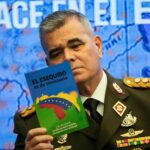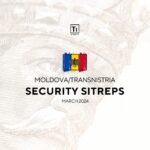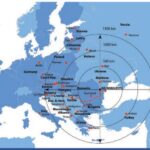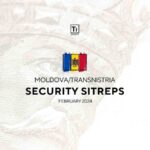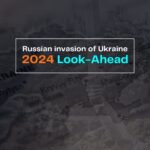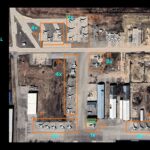Following Jabhat al-Nusra’s decision to split from the main Al-Qaeda structure with mutual acceptance, this descriptive analysis explores the organization’s history and its motives of this decision. It also considers prospective outcomes, taking into account all the major inputs of the regional and local chessboard as well as the geopolitical array.
Executive Summary
Opposition group, Jabhat Al-Nusra has officially announced its split from the Al Qaeda terrorist organization from which it was a part since 2012. The Al-Nusra network group is a terrorist organization designated by the US, EU, Russia, Australia and sanctioned by the UN. The following analysis is based on the facts contained in the video message released by Nusra leader al-Jolani, as well as other local sources regarding history and developments on the internal political stage and war-fighting configuration, in order to formulate a clear view on the nature, impact and effect of the split and name change.
Friday, July 28th 2016:
- Abu Mohammed al-Jolani appeared in camera for the first time to announce his group’s name has also changed to Jabhat Fath al Sham (The Front for Liberation of al Sham).
- Al-Jolani has praised Al-Qaeda’s leadership for supporting this transition and renewed his group support for them.
- Group to focus more on a “united” fight
The strategic decision could be just a “PR measure” or a palpable reconfiguration, as the situation brings together several inputs:
- US-Russia discussion for cooperation in Syria and joint air strikes on ISIS and Nusra.
- Weakening of moderate, traditional-preferred groups.
- Pressure from external backers such as Qatar.
- Continued isolation from political discussion (such as being excluded from the Cease Fire deal between US, Russia and Syria).
- Neediness from other Opposition factions to regard Nusra from military isolation in the Revolution/ War.
- Everlasting blacklisting from the fact of being an Al-Qaeda affiliate.
It may be outlined that the decision was made in order to survive, grow and integrate with other factions from the War. But this group may be judged by its behavior not by the name it wants to be called; therefore the nature of this action shall be examined. Does Nusra indeed call for an ideological shift or not?
The video still contains renewals of friendship to Al-Qaeda, al-Zawahiri (leader of Al-Qaeda) and commitment to Jihad. But other information point out towards mentionable positions to reform the group. If there is a real sense of reformation than the radical key words (red flags) might have been used for political reasons, rather than ideological; or in the same order of ideas, the discourse could be tempered-down in the near future. In order to assess the nature and the genuine factor of the split, a short history of Nusra needs to be assessed.

Syria War map as of July 15th, courtesy of ISW
Background: Civil War
When the 2011 protests against Bashar Al-Assad began, the Ba’athist regime has severely escalated the unrest into the current quagmire Civil War. Bordering countries as Turkey, Israel, Lebanon, that have their own security and national needs; bordering Iraq of which security and defense is a direct interests to the US, and having a powerful cultural connection with Iran, many formed groups have quickly evolved in well funded, equipped and trained paramilitary factions. Thereby the revolution quickly turned into a Civil War with layers of proxy wars, ideological religious struggles and a geopolitical chess-mess.

Sputnik/ Valery Melniko
The Opposition Rebels were dispersed and polarized; one on hand, there were the radical groups, that emphasized the Islamic nature of the conflict, denying outside interventions; While on the other hand, the moderate groups were in favor of International intervention, political transition and democratic reforms. However the lack of interventionism denied a quick end to the war, facilitating the sociopolitical environment to breed radical, jihadists groups and not to mention bringing them on the main stage.
For Da’esh (ISIS/ISL) and for other groups from the opposing Islamic Front, the lack of interventionism and the continue barrel bombings of civilians by the Government, represented a “gold mine” for human resources and logistics. Even before the war, the Ba’ath Regime tolerated the Jihadi network because it was targeting the US in Iraq. Moreover they’ve passively accepted into refuge the many ex-Iraqi Ba’ath Party officials that escaped Iraq; which taken together and with the constantly radicalization of the youth in the Protests (later Civil War), became elements that were later catalyzed by “prominent” figures as Abu Bakr al-Baghdadi or Abu Mohammad al-Julani to form what we now see as being ISIS and Al-Qaeda’s Jabhat al Nusra (but more on that in the upcoming section).
Briefing on Jabhat al-Nusra (Jabhat Fath al Sham, present)
In late 2011, al-Qaeda in Iraq (AQI)—the organization now known as ISIS —sent operatives to Syria with the purpose of establishing Jabhat al Nusra to fight the regime of President Bashar al Assad. The group publicly announced its presence in Syria in a January 2012 video statement, and pledged allegiance to al-Qaeda leader Ayman al Zawahiri in April 2013 after severing its ties to Islamic State. On 9 June 2013, al Zawahiri released a letter publicly announcing Jabhat al-Nusra as the official al Qaeda affiliate group in Syria[1].
- Current leader, Al-Jolani has been one of those operatives sent by Al-Baghdadi (leader of Al-Qaeda in Iraq then/ ISIS now) over the border to establish a franchise there.
- His loyalty to Al-Qaeda leader al-Zawahiri has been proven at the moment that Baghdadi proclaimed the turn from “Al-Qaeda in Iraq” to “Islamic State of Iraq and al-Sham” (ISIS), emphasizing its transnational and unilateral aspirations for a Caliphate.
Historically Syria was not a major Al-Qaeda safe heaven and that’s not “thanks” to a secular government, but because of the presence of the Syrian Muslim Brotherhood and its more violent sectarian offshoot, the Fighting Vanguard, were the country’s most prominent Islamist organizations. In the mid-1970s, they were at the forefront of a radical Sunni insurgency against the secular government of Bashar’s father, Hafez al-Assad[2].

Free Syrian Army fighters on a pick-up truck, head toward the frontline where clashes with forces loyal to Syria’s President Bashar al-Assad are taking place in the al-Ziyabiya area, in Damascus May 5, 2013. REUTERS/Ward Al-Keswani
- Nonetheless the Syrian territory did play an important part in fueling the Iraqi insurgency against the US War on Terror, allowing fighters to pass its territory and infiltrate the eastern country during the 2000’s[3].
- This observation that was raised even by General Petraeus to George W. Bush that called for pressure to be put on Assad due to his passive tolerance of radical fighters in his country.
This exact network that was already formed in Syria and served for Al-Qaeda’s struggle in Iraq was on which the emissaries from Iraq, led by Jolani, converged to form Jabhat al-Nusra.
- Jahbat al-Nusra quickly attracted some of the Syrian anti-Government protestors, veterans that fought the US in Afghanistan[4] and Foreign fighters from Europe and across the world[5] – especially those who want an alternative to ISIS.
In December 2012, the United States designated Nusra a terrorist organization, rightly identifying it as an alias of al Qaeda in Iraq. If the terrorist label was meant to isolate the group, however, it seemed to do the opposite on short-term. On Dec. 14, the first Friday after the designation, Syrians across the country marched under the slogan, “The only terrorism in Syria is Assad’s,” a clear rebuke to the U.S. decree. Dozens of rebel groups publicly declared, “We are all Jabhat al-Nusra,” while even the leadership of the political opposition in exile—which Nusra didn’t recognize—condemned the terrorist label[6]. But on the long term, the group was avoided by many moderate or radical groups because of its label and connection to Al-Qaeda, otherwise, they would have been denied foreign support and virtually the needed logistics and funding.
In 2013 the biggest threat to Al-Nusra’s survival was disputed when al-Julani refused Baghdadi’s announcement of merger with ISIS[7], bringing an open-fight between the two factions, affecting overall the ISIS-Al-Qaeda relations. The open fights escalated in Deir-ez-Zor but Nusra managed to expand by gathering factions under its front, by creating common coordination groups, as the Shura Council[8], Jaysh al-Haramon[9], Ansar al-Sharia[10], Eastern Ghouta and many other Operation Rooms. Jabhat al-Nusra avoids the mistakes it made in Iraq, and assumes a tighter leadership over these groups. Many of them, as Jund al-Aqsa are incorporated within its ranks[11].
Even if the US has previously hit Nusra elements in Syria and continuously emphasized the threat of Salafi-jihadist, the Russian exploited this factor to delegitimize the entire Opposition to Assad. Thereby, Russian Air Force has frequently hit Nusra, al-Sham and other Jihadi groups alongside the moderates.
Later on, the formation of YPG-led Syrian Democratic Forces and Syrian Arab Coalition, created a wave of defectors from the moderate FSA to more extremist groups as Nusra, but also triggered fights with those newer groups; and with those older but reshaped ones. This also outlined a higher level of political isolation. While the FSA has coordinate in some instances with Nusra, Anhar al-Sham in the past, today’s configuration is more ambiguous, fertile in new groups and fast-changing to underline a clear map of allegiances.
Since 2015 Nusra holds in HQ in Idlib and participates in the counter-offensive attempt in Latakia against the Assad-Russia establishment, runs an insurgency in Damascus and also holds large numbers of fighters in Aleppo, now under siege by the Regime.

Islamist Syrian rebel group Jabhat al-Nusra members pose on a tank in northern Idlib province. (Reuters)
The February 2016 the Nusra group rejects the US-Russia Cease Fire truce, which first of all, didn’t even include al-Nusra (or ISIS); another huge blow to the group’s participation in the political background[12].
Now, behind-doors US-Russian negotiations are eyeing intelligence sharing and co-op strikes against ISIS and Nusra[13] – which could have been a catalyst for the group’s leadership to rebrand; even though rumors of an eventual split from Al-Qaeda began with 2015[14].
Ideological boundaries and room to shift
At the first meetings taken place between October 2011 and January 2012 in Reef
Dimashq (Damascus countryside) and Homs, according to the Quilliam Foundation the five main objectives of the project were decided:
- To establish a group of existing jihadists by linking them together into a coherent entity.
- Reinforce and strengthen the Islamic nature of the conflict.
- Build military capacity for the group.
- Create an Islamist state in Syria.
- Establish a Caliphate in the Levant (al-Sham).
From a modus operandi perspective, the group breeds a strong anti-Western, Salafi approach, self-estimating as representatives of the Sunnis in Syria and upholding Sharia law and a Jihad resolution in the area:
- They operate more as an insurgency with guerilla tactics than ISIS, but also contain elements of Hybrid Warfare.
- Own media outlet “White Minaret”, uses social media and online networks, such as forums.
- Employ and call for classical terrorist tactics as suicide bombings, explosives rigged cars, kidnapping and executions (even beheadings).
- Terrorist attacks in Lebanon, Damascus and Aleppo could lead to the assumption that they conserved in some instances the Al-Qaeda cell system.
- Most of Nusra’s reach is high and disperse but mostly in rural areas.
- Low social-civic actions, highly dependent on the military ones.
- Presumed total secrecy internal policy regarding leadership details, organization.
- Allegedly support from Turkey, Saudi Arabia; most presumed from Qatar.
Many estimates from RAND Corporation, The Economist and Quilliam Foundation project their numbers to be around 5,000 to 8,000[15] with a few thousand more independent jihadists.
Possibility of Reform?
As rumors have pointed out, discussions of a split between Al-Qaeda and Jabhat al-Nusra have been going on since 2015[16]. While the current top leadership is a hardcore supporter of Al-Qaeda leader al-Zawahiri, other people close to them in the top ranks have expressed different approaches. An important voice is Abu Mariyah al-Qahtani who doesn’t necessarily oppose the philosophy of the group, but has stated that at times, the group hasn’t been “pragmatic enough”.
Abu Mariyah al-Qahtani became famous when in March 2016 spoke against extremist and self-identity of groups. Transylvania Intelligence has translated some extracts of the news coverage of this interview:
“We do not want bids banners, slogans and writing them, remember that the banner of al-Maliki, which killed underneath Saddam Hussein wrote them (God is great), and the Government of Khomeini says it is an Islamic Republic, as well as al-Baghdadi’s Islamic State of Iraq, we say they are far away from Islam.[17]“
He warned the factions of hyperbole, saying: “We say to the Muslim revolutions, to some organizations, beware of extremism, beware of dictating for the brothers the Mujahideen,” “There is a stream of remnants Daash keen on isolating the Mujahideen and sedition between the Mujahideen and the people of Syria, and there is a stream sly in some of the groups, seeking to stir discord and division between the Mujahideen and the people of Syria, Venhdhir groups that embrace stream extremists, as well as wary of the other current that Aharc among the Mujahideen[18].”
The name of Qahtani, who has been critical of obsessions with banners and group identity and warned against ghuluw(‘extremism’), came up earlier this month in the founding statement of a new group of jihadi scholars in Syria called ‘Tajammu Ahl al-‘Ilm bish-Sham’ (Assembly of Al-Sham Scholars), alongside Saudi-born Abdullah al-Muheisseni, who is a leading cleric in the Jaysh al-Fatah coalition[19]. Jabhat al-Nusra is also a member of the Jaysh al-Fatah coalition and assumes a leading role.
Question Mark for Counter-Terrorism
The mentioned connection could hold the only proof that there is an effort undertaken to not only rebrand but actually reform the terrorist organization. The implication of such a change is huge for counter-terrorism analysis because it creates a precedent. In that case, what is the solution to it? Should these kind of presumed reformed organizations be treated better in order to encourage others to reform or individuals to even defect?
Let’s look at Assad’s legislative decree No. 15 emitted on 28th of July stipulating for granting an amnesty for those who turn themselves in to the competent authorities and lay down their weapons and those who set free in a safe way persons they kidnapped. Could it be a hint? The synchronization is more than interesting. Even though such a decree was also signed at the begging of the war and had poor results. So would class it as being a “black swan”.
It goes without saying that such an organization doesn’t reform for “moral reasons” but for pragmatism. In this stage, “reform” is to of an ambitious term, the best one is “rebrand”. In this case, the list of “why’s?” is long.
Conclusion: a matter of Pragmatism
- Continued military and political isolations on the War stage from both external major powers and internal players because of those mentioned, mostly.
- Terrorist organization designation.
- Frequent air strikes from both Russia and the US.
- Lack of allies
- Pressure from external backers such as Qatar.
- Exclusion from the US-Russia Cease Fire deal from earlier 2016.
Just one of the many reasons why Nusra decided to took this step. But more recently, the leaked document of closed-doors US-Russian negotiations to ground the Syrian Air Force (but not ruling out artillery strikes), protect the FSA, share intelligence and conduct joint strikes on al-Nusra and ISIS[20], have alarmed the Al-Qaeda branch.
The Pentagon will mostly judge a group by its behavior not by its name, or new name. So Jabhat al-Nusra would probably not be treated differently by the US or Russia.

Siege of Aleppo (source: Newstatesman.com)
It is however a possibility to attract other moderate or dependent on US-aid groups and unsatisfied with it. In face of continued un-discriminatory Russia, Syrian air strikes on civilian and moderate forces, with an insufficient US protection, they would look for other alternatives as Nusra, Anhar al-Sham to upgrade their security –it’s a basic need of survival. And a possible radicalization of the moderates it’s something that I’ve said that’s bound to happen since the “Little Green Men” landed in Syria.
As influential Islamic cleric Sheikh Hassan al-Dugheim makes clear: “Syria’s mainstream opposition will demand and require expanded levels of support should they be expected to de-couple themselves from Jabhat al-Nusra, while abiding by broader ceasefire-like conditions.It will not be possible to isolate support for al-Nusra without a no-fly zone, fully guaranteed by the international community, along with much stronger support to the Free (Syrian) Army. Without this, it is inconceivable. We would risk losing everything.”
“The Americans refuse to strengthen the factions,” said Zakariya Malahfji of Tajamu Fastaqim Kama Umrit, an FSA group vetted by the United States and present in Aleppo city. “But at the same time, they object to us allowing al-Nusra to help in our battles. This is illogical.” Another senior U.S.-vetted figure from Aleppo who requested anonymity, was similarly frustrated: “Our situation in Aleppo has been desperate for so long, but Americans seem happy to watch us suffer and die. We are desperate and we’ll accept support from whoever will give it, so long as it contributes to defending against the (Assad) regime.[21]”
Final Notes
For now the name change & the organization split is a potential-full PR campaign for al-Nusra; but only time while tell whether there will be also a reform within the structure, the people and the mentality. Until then, there shouldn’t be forgotten that this group has the same objectives as ISIS, a softer approach, lower power but not-so-different means. Moreover Al-Qaeda could employ a new strategy that could see to publicly legitimize its factions by allowing them to split and grow from a de facto independent position.
Whether the Nusra front will grow bigger in face of the Russian-American deal it also remains to be seen, but that effect could be observed sooner than later. The siege of Aleppo could tell how desperate are the Rebels and how pragmatic and protective is the US. Just by analyzing speeches from influential clerics we could conclude that the tendency is to critize the US for its lack of support and to advocate for closer ties to groups as Anhar al-Sham, Nusra.
If protection from Russian, Syrian air strikes is not delivered, or securing a good deal with them (at least), we could face a broader radicalization of the Syrian Opposition which could as well, threaten the disintegration of newer but yet-to-prove themselves groups as Syrian Democratic Forces, Syrian Arab Coalition, therefore fully compromising Euro-Atlantic efforts in Syria and deepening into the already evolving “worst case” scenario of the war. Furthermore these groups could prove to be a long term security threat for the US and Europe.
BIBLIOGRAPHY
[1] Department, Attorney-General’s. “Jabhat Al-Nusra.” https://www.nationalsecurity.gov.au/Listedterroristorganisations/Pages/Jabhatal-Nusra.aspx.
[2] Abouzeid, Rania. “The Jihad Next Door.” POLITICO Magazine. https://www.politico.com/magazine/story/2014/06/al-qaeda-iraq-syria-108214.html.
[3] “The General’s Gambit.” Foreign Policy. https://foreignpolicy.com/2012/10/01/the-generals-gambit/.
[4] 2015, Murtaza HussainMurtaza HussainMay 28, and 8:35 P.m. “Al Qaeda Syria Boss Says That His ‘So-Called Khorasan Group Doesn’t Exist.’” The Intercept. https://theintercept.com/2015/05/28/called-khorasan-group-doesnt-exist/.
[5] “Jabhat Al-Nusra, IS Compete for Foreign Fighters.” Al-Monitor, July 18, 2014. https://www.al-monitor.com/pulse/originals/2014/07/jabhat-al-nusra-announce-islamic-emirate.html.
[6] Abouzeid, Rania. “The Jihad Next Door.” POLITICO Magazine. https://www.politico.com/magazine/story/2014/06/al-qaeda-iraq-syria-108214.html.
[7] “Qaeda Chief Annuls Syrian-Iraqi Jihad Merger – Al Jazeera English.” https://www.aljazeera.com/news/middleeast/2013/06/2013699425657882.html.
[8] “New Syrian Jihadist Body Formed to Fight ISIS.” Al-Monitor, May 28, 2014. https://www.al-monitor.com/pulse/security/2014/05/syria-new-jihadist-body-unified-shura-council-fight-isis.html.
[9] Obs, Syrian Rebellion. “#SRO | INFOGRAPHIC – EXCLUSIVE – Rebellion Forces in Hermon Mount Area (S-W #Syria) Creating the Jaysh Al-Haramon.pic.twitter.com/OesGoXL69k.” Microblog. @Syria_Rebel_Obs, June 15, 2015. https://twitter.com/Syria_Rebel_Obs/status/610748121652547584.
[10] “Rebel and Islamist Groups Form (another) Op Room ‘Ansar Al-Shariah’ to Take Aleppo City and Its Countryside • /r/syriancivilwar.” Reddit. https://www.reddit.com/r/syriancivilwar/comments/3bwk8d/rebel_and_islamist_groups_form_another_op_room/.
[11] “Jund Al Aqsa Leaders Join Al Nusrah Front.” The Long War Journal. https://www.longwarjournal.org/archives/2016/02/jund-al-aqsa-leaders-join-al-nusrah-front.php.
[12] “Nusra Front Rejects Syria Truce, Urges Stronger Attacks: Audio Statement.” Reuters, February 26, 2016. https://www.reuters.com/article/us-mideast-crisis-syria-nusra-idUSKCN0VZ1ZZ.
[13] “Russia Proposes US-Led Coalition to Strike Syrian Terrorists with Moscow – Def Minister.” RT International. https://www.rt.com/news/343767-russia-us-coalition-syria/.
[14] “Nusra Front Split from Al-Qaeda ‘Imminent’, Sources Claim.” Middle East Eye. https://www.middleeasteye.net/news/nusra-front-split-al-qaeda-imminent-sources-claim-411085001.
[15] “Jabhat Al-Nusra | Mapping Militant Organizations.” https://web.stanford.edu/group/mappingmilitants/cgi-bin/groups/view/493#note29.
[16] “Nusra Front Split from Al-Qaeda ‘Imminent’, Sources Claim.” Middle East Eye. https://www.middleeasteye.net/news/nusra-front-split-al-qaeda-imminent-sources-claim-411085001.
[17] “أبو مارية القحطاني: لولا المظاهرات ما استطعنا حمل السلاح في بلاد الشام.” كلنا شركاء في الوطن. https://all4syria.info/Archive/300511
[18] ibidem
[19] al-Tamimi, Aymenn Jawad. “What Does Jabhat Al-Nusra’s Break with Al-Qaeda Mean?” Middle East Forum. Accessed July 29, 2016. https://www.meforum.org/blog/2016/07/syria-nusra-alqaeda.
[20] “Microsoft Word – Terms of Reference for the Joint Implementation Group.docx – terms_of_reference_for_the_Joint_Implementation_Group.pdf.” Accessed https://www.washingtonpost.com/r/2010-2019/WashingtonPost/2016/07/13/Editorial-Opinion/Graphics/terms_of_reference_for_the_Joint_Implementation_Group.pdf?tid=a_inl.
[21] Fellow, Charles Lister Senior, Middle East Institute, Senior Consultant, and The Shaikh Group’s Syria Track II Dialogue Initiative. “Under Pressure, Syria’s Rebels Face Al-Nusra Quandary.” The Huffington Post, https://www.huffingtonpost.com/entry/under-pressure-syrias-rebels-face-al-nusra-quandary_us_578bbd07e4b0e7c8735055e4.
Founder of T-Intelligence. OSINT analyst & instructor, with experience in defense intelligence (private sector), armed conflicts, and geopolitical flashpoints.

